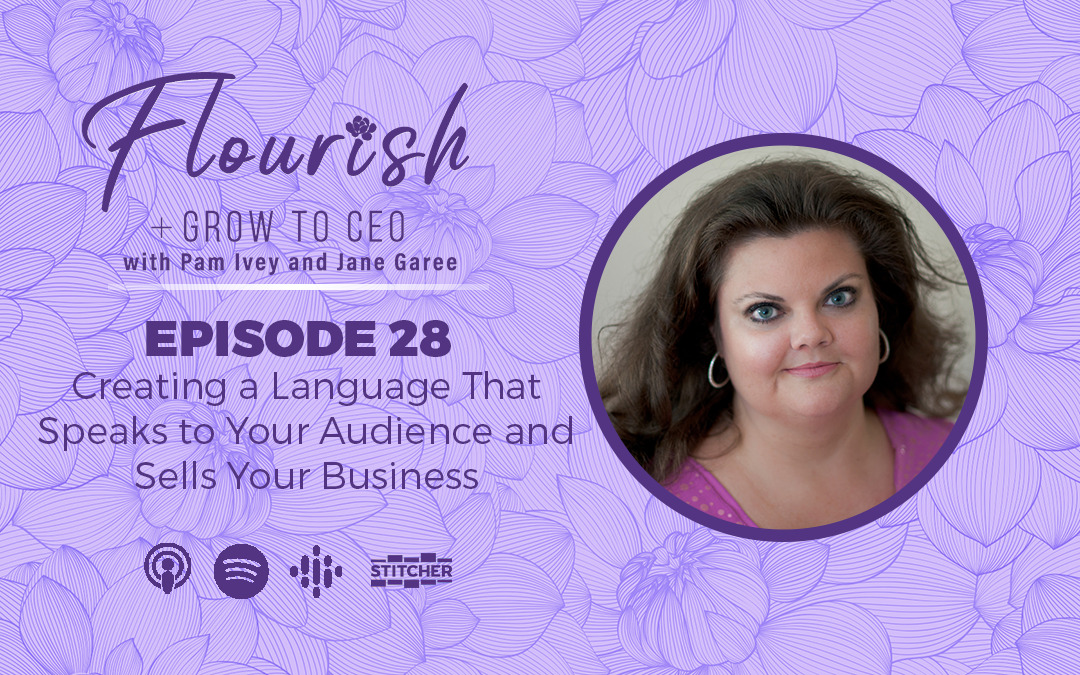Pam (00:00):
You’re listening to the flourish and grow to CEO podcast. This is episode 28.
Speaker 2 (00:25):
[inaudible]
Pam (00:26):
Are you a lady boss making 50 to a hundred thousand in your business? And you’re ready to break through that six figure barrier.
Jane (00:33):
Have you done a great job of creating a nice life as the ultimate gig master, but no, your inner CEO is calling you to greater Heights. You’re in the right place. If you want to create and implement solid fundamentals in your business without sacrificing fun.
Pam (00:48):
I’m Pam Ivey, I’m certified in small business management and I concentrate in the areas of training and certifying real estate assistance, coaching and mentoring entrepreneurs, an online business marketing growth and profit acceleration. And I take men and women business owners aged 40 plus to bucket list destinations around the world for a month at a time to work, explore, and live in community.
Jane (01:14):
And I’m Jane, Garee known as the sales strategist for the non sales person. And I work with business owners who want to increase their conversion rate, shorten their sales cycle and have more impact and influence with the work they do all while having more fun with selling.
Pam (01:28):
Hey everyone. And welcome back to the podcast today. We are talking about continuity and congruency and your sales and marketing language, basically messaging consistency. It’s super important that your messages stay consistent. It’s just imperative to your branding. So if you’re successfully branding your business with consistency, clients and prospects will be able to recognize your look and the content or messaging your brand is who you are. And it sets you apart from your competition, your colors, your fonts, design theme, and voice should all be unique to you and your company. If you’re branding you as well, and that’s gotta be done with consistent messaging. So you build credibility through that consistency, giving potential clients and the community, a perception of you as an expert, who’s professional and confident. So sending out a mishmash of randomly creative, different looking materials and different sounding messages does not create that cohesive impression.
Pam (02:35):
And it doesn’t allow the familiarity to grow piece after piece that ties your look together. So lack of brand continuity can also contribute to a loss of credibility. Did you hear that? We don’t want to lose our credibility with our clients or our potential clients, so your business could be giving the impression of disorganization and in decision and disjoint in materials can actually confuse potential clients. Is this the same business that sent an email to me? Or why does this ebook look and sound completely different? Has something changed? So that’s where we are with consistency. What’s your take on it, Jane?
Jane (03:19):
Yes. I think really getting language. That’s got both continuity and congruency is easily overlooked and it really is jarring for the client. So when you think about selling strategies or some people might term it as how your funnel is built, you really want to think about every touch point along the way. So for example, usually for most people, they’re going to read something about you and your company before they have any other kind of experience or exposure. So the language that you have in your copy and in your content, your website, your emails, social media posts, even anything that’s in the rich and word, the next step would be, they’re going to have the next kind of experience with you, which might be a phone call, or it might be an in-person interaction. So your language at that moment with the in-person should, should match.
Jane (04:09):
It should be congruent with how they perceived you in the written word. When you don’t do this, you really do run the risk of it causes brand confusion. Like you said, Pam, it there’s a, there’s a feeling of you’re unreliable and it’s, it’s not, it’s not a judgment, like, well, I don’t want to work with this person. That’s unreliable. It’s not that it’s, it’s almost, uh, kind of sensory or subconscious. It’s something doesn’t, something’s not quite jelling. You know, I read your, I read about you and you sounded one way and now I’m on the phone with you and you sound a different way. So you want to make sure that the language all the way through is congruent. I like to use these two words. When I talk about language, a lot of times is does your language have both recognition and resonance for your ideal client?
Jane (04:57):
So let me explain both of those a little quickly recognition is the recognition that you have a solution for the problem that they have recognition is, oh, you know what? This person is equipped. This person has the skill or the expertise to be my problem solver for my particular problem. That feels really, uh, that’s. That feels good. The resonance is, do they want to choose you? So this one’s a little more, a little less tangible. I should say. This one is kind of how they, how they feel about you. Oh, I really get it. Pam seems to have been down this road before. Wow. I feel like Pam speaking straight to my soul and nobody else has really ever made me feel like they deeply understand what it is that I’m going through. So recognition is a little kind of more logical. I can see that this person would be a good problem solver for me. They have the solution and the resonance is, this is the person that I choose because I just feel like I’m kind of vibing with them.
Pam (05:52):
Yeah. Now, speaking of vibing, this is so funny. It was probably 2008. Yeah, 2007, 2008. So it was one of the very first infusion soft conferences, which is now keep, I went there and met up with one of my clients. One of my biggest clients, I was her online business manager. And there, I also saw a whole bunch of people that I had been talking to online. And by that usually by text, right? Not really, we didn’t have videos and zoom and all that stuff at that time. And any videos that I had put out were extreme, like so professional, I was in a suit jacket. I was very stiff. And when I met these people, they said to me, well, one of the fellows that I met said, I don’t really see that you’re the same person, because I’m really laid back relaxed, actually smile all the time. I’m really bubbly. So it was completely the opposite from my videos. So it was completely non congruent
Jane (07:00):
For me. That’s a perfect example. The way that you dress, the way that you show up, the way that you speak to people, the way that you write or create your content, all of it should feel the same. It should, it, it should feel congruent because that creates trustworthiness. There’s an expectation of who you are. And normally I’m not real high on expectations, but in this instance, that’s a good thing because they feel confident and secure. Your ideal client will feel confident and secure knowing that you are who you are, who you are, and there’s a consistency in how you’re showing up, which means to them, there’s a consistency that, that can be relied upon for when you deliver what it is that you promise you’ll deliver it.
Pam (07:44):
Yeah. Perfect. And remember, you know, today we’re a lot more relaxed in business than we were in 2007 or 2008. It was a lot of putting out a professional image. You know, today things are so much more laid back and relaxed. I find people aren’t on video in a suit anymore, or unless their customers expect to see them in one like a lawyer or something like that. Right. So it’s, I think it’s a lot easier, but I still want to stress be yourself because when you’re in a video or something like that, and you’re all stayed and very S you know, straight laced. And, and then if they see you in person and you’re completely the opposite, it really is. As you say, jarring, it’s like, I didn’t even know that was really you, Pam, because you’re so different in person. And you don’t really want that because most of us are service-based business owners and our brand and us are very tied together. So we really want to project our true personality in what we do. So,
Jane (08:51):
Yeah. Be, be authentically you and your true personality. I have clients who they prefer to be in suits in very professional clothing. They would never appear out in public or on camera without their makeup and their hair done and their jewelry on something that just, it’s a very polished look, that’s who they are. And you know, now what they’re doing in their own backyard on their spare time, I’m sure they’re not dressed like that with full hair naked, but we don’t really see that. And that’s, that’s the important piece here. It’s what is the public perceiving? So you do want to be authentic and then just being mindful. It does, it doesn’t mean that you, you know, you’re going to bed in your suit or, you know, playing out in the backyard with your kids with like full on glammed hair or something like that.
Jane (09:39):
So be authentically who you are, just be mindful that there’s congruency in how you show up in your language, which we’re specifically talking about today, but also in, you know, in the physicality so that people really have a sense of, I can trust who this person is, because this is how they show up. You know, one, probably one of my favorite examples of this is Allie brown. She’s kind of like, she’s, she’s my age, she’s our age, Pam. So I’m gonna call her the grandmother of the industry. But I think she called herself, be careful.
Jane (10:11):
It has nothing to do with age. It’s just really on the forefront of the coaching and consulting industry. And she’s, you know, she’s phenomenal brand, but no matter where she shows up, she really does kind of look the same. And she, she usually is, is very put together. And even when she’s kind of cash, so her clothes may be a little bit more casual. Her lipstick may be not quite as bright, a hew as it is on stage, um, hair, maybe a little more tousled something like that, but she no really elegant, very elegant. And she still feels very put together. And it’s just authentically who she is. Uh, I’ve got a personal client that she can’t, she, she just, she wants to run around and like, Hey, I’m showing up and I’m hot and sweaty. Cause I’m on my workout. Hey, I’m, I’m at the grocery store.
Jane (11:00):
And I didn’t feel like putting on makeup. My hair’s in a ponytail and you know what, it’s great, but that’s who she is. Every time you see her. And that’s what we’re talking about. You don’t want to, you, you don’t want to show up like really polished and elegant if really who you are is I’m more in the sweats. My hair’s in a ponytail and I may have swiped on some lip gloss. So it’s no right or wrong. It’s not that one’s better than the other. You’re just looking for continuity and congruency in how people perceive you.
Pam (11:24):
Hey lady boss, do you think like a CEO when your business starts taking off, you’re ready to scale up. At this point, you’ve got to stop thinking of yourself as a solo preneur and start thinking of yourself as the CEO of your company. If you remain in the mindset of a one person operation, then you won’t be able to grow. You’ll never have the time, energy or expertise to do everything by yourself and your business. Won’t be the success that it has the potential to be. So are you thinking like a CEO take our free assessment to find out you can find it@flourish.biz forward slash think that’s F L O U R I S H dot B I Z Ford slash T H I N K. Once again. That’s flourished.biz for slash think. All right, lady boss, let’s get back to the show. Absolutely. And today there’s no need for facades. Like there used to be. It’s just not necessary. People are so much more authentic today and I hate that word, but they are. Yeah, no, no authentic,
Jane (12:39):
Authentic. And authenticity is really been, gotten tossed around quite a bit over the last several years, but we probably do it because it’s true. That’s what we’re all striving for. It’s really what we’re all striving for.
Pam (12:54):
So keep this in mind as you’re building your website or having someone build it for you in your social media, when you speak on stage be you or really project the brand that you’re putting forth to the, to your community out there really. And one other thing that’s really important is that your language should really pull in and not push out. So that’s kind of known as inbound marketing versus outbound marketing. So outbound marketing it’s referred to as push or interruption marketing. So it uses tactics to get the message to a large number of people so that they can make a sale. So like a TV, commercial, any kind of advertising, that’s push marketing, you’re putting it out to the world, usually to large numbers and hoping you make sales with pulling in or inbound marketing. It means that you’re drawing people to you and the heart of marketing is your content. So it’s directed towards your ideal client and those that are actively searching for what you have to offer. When they get to your website, they find help. They find guidance and education. That’s directly related to the search that they’re doing online. And you want that resonance. So people are often attracted to people that are like them being authentically. You will really better your chances to work with more ideal clients.
Jane (14:31):
Yeah. You really do want to pull in people who they get you and they feel like you get them. That is the, that’s the harmonious relationship. They will make the best clients. They will give you the best referrals they are the most fun to work with. And they’re the ones that are easiest to get the results for and, and with.
Pam (14:51):
Yeah, absolutely. So by knowing what they can expect from your brand and experiencing your message multiple times and in multiple ways, your audience will begin to assign a higher value of trust in what you deliver. And that’s something that we really need in order for a prospect to feel comfortable handing over their credit card to us. So again, short and sweet episode this week, but I think we got our point across don’t you Jane?
Jane (15:22):
I think so short and sweet is sometimes really, really good. So there, yeah,
Pam (15:27):
Absolutely. So we’re going to wrap it up for today, but we’re going to wish you a wonderful week and now we’re going to say, get out there and flirt,
Jane (15:36):
Get out there and flourish. Well,
Pam (15:40):
That’s a wrap everyone. Thanks for joining us this week on the flourish and grow to CEO podcast. Be sure to visit our website at [inaudible] dot biz. That’s F L O U R I S h.biz, where you can subscribe to the shows in iTunes, Stitcher, or via RSS. So you’ll never miss an episode. You can also find our show notes and resources there too. And while you’re at it, if you found value in this show, we’d love for you to leave a rating on iTunes. Or if you’d simply tell a friend about the show that would sure help us out to now get out there and flourish.



Leave A Comment